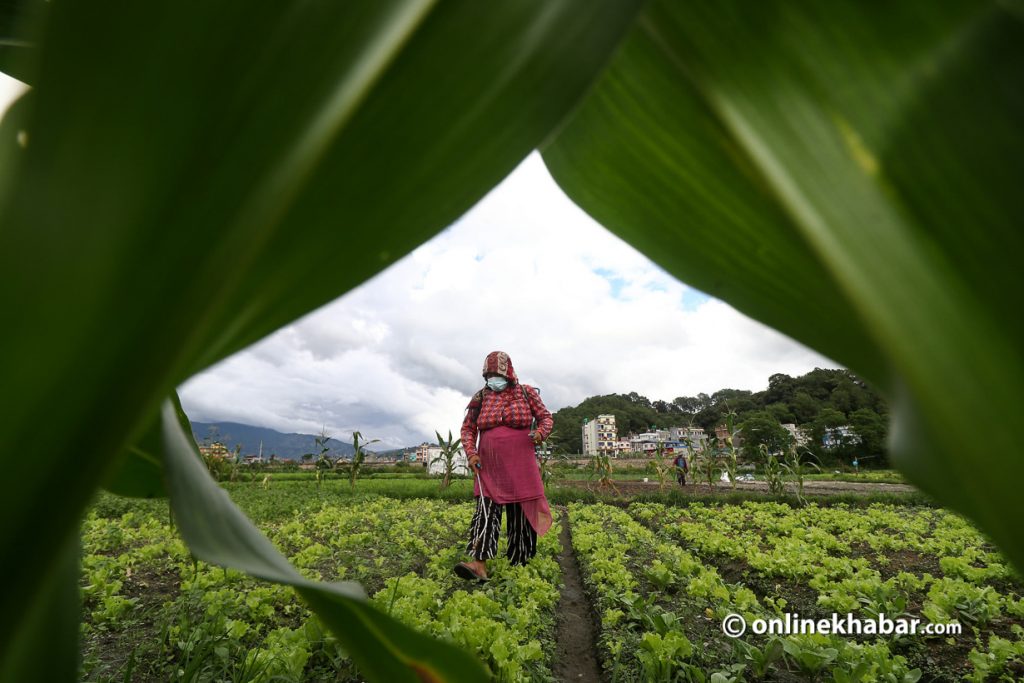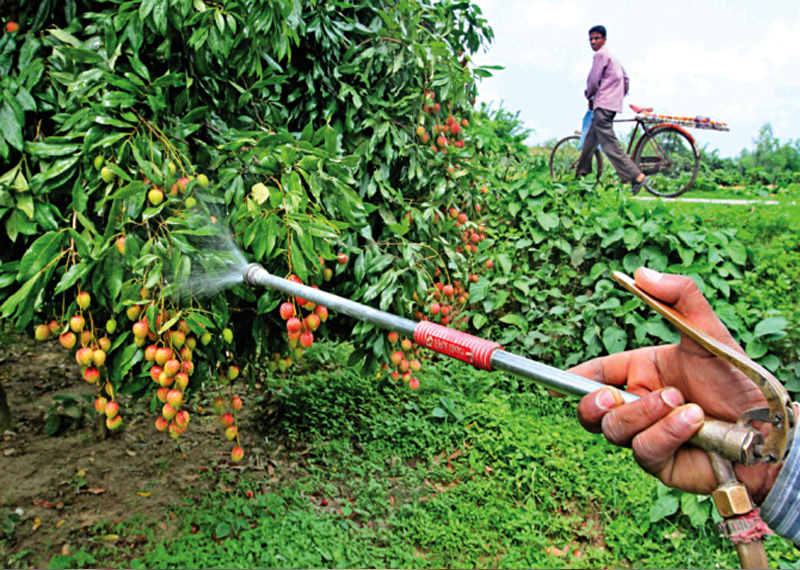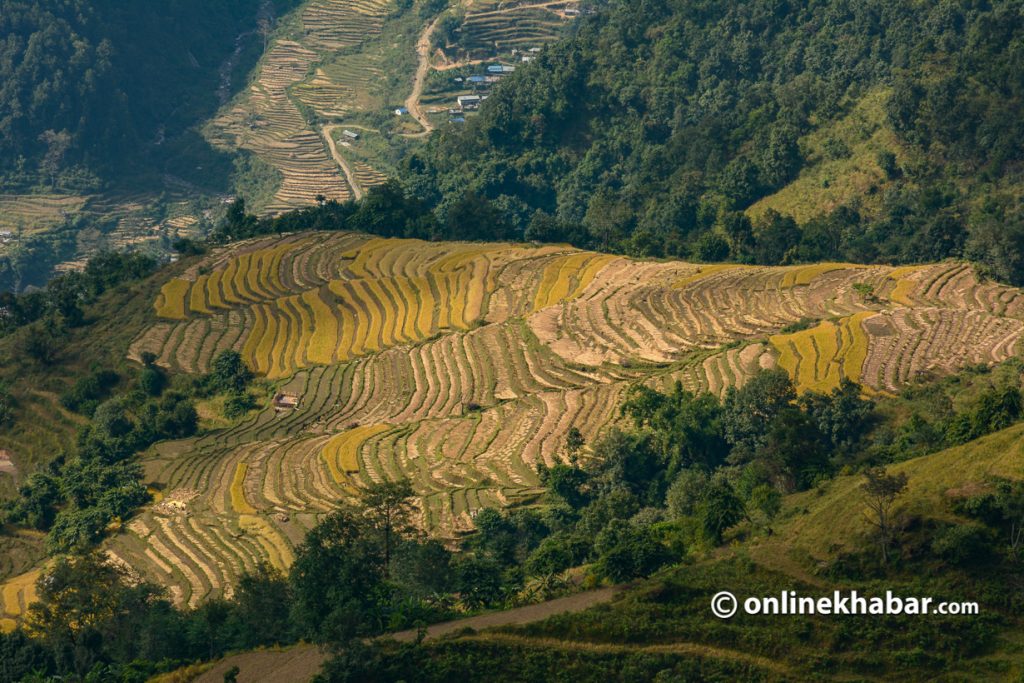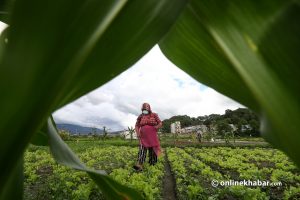
Raju Thapa, from Dokrena in Tulsipur sub-metropolitan city-12, has dedicated 10 bighas (approximately 2.53 hectares) of land to vegetable cultivation. He started commercial farming in 2019 and is growing vegetables such as pumpkin, tomatoes, and cauliflower.
Thapa had planted two varieties of tomatoes–Gaurav and Chow–in three out of the 10 bigha fields. However, the latter variety of tomatoes suddenly perished. He summoned a technician and administered medication, but that did not make any difference.
Thapa revealed that he invested Rs 1 million in the farm and added that if he was able to sell all the produce, he would have made nearly a million in profit.
“However, such problems arise with one crop or another every year. I have been resorting to the use of pesticides to salvage them,” he says.
Based on Thapa’s experience, using pesticides and medication to protect the vegetables has become a regular and essential practice. He says pesticides should be applied at least two or three times on vegetables and agricultural crops, and the use of chemical fertilisers has also become essential. He adds cow manure (organic) cannot substitute for chemical fertilisers, and crops cannot be saved without its use.
Mahendra Adhikari from Tulsipur-2 Muchot in Dang has been involved in commercial agriculture for eight years. He insists that using pesticides on vegetables and agricultural produce is mandatory. In the initial stages, he made several attempts at organic farming. However, after failing and losing a lot of money, he resorted to using pesticides.
A necessary evil

Over the past decade, there has been a continuous rise in the use of pesticides. In fiscal year 2021/22, the use of pesticides on rice increased by 15.6 per cent compared to 2011/12. This trend is also observable in staple crops like corn, wheat, and potatoes.
Farmers understand that they cannot farm without pesticides, driven by their desire to maximise production. Easy accessibility has further fueled this trend, resulting in a steady yearly rise in pesticide usage, and government regulations too are weak.
This surge in pesticide usage extends beyond green vegetables in Nepal, encompassing major food crops such as rice, wheat, and corn. According to the Agricultural Census 2021/22 report released by the National Statistics Office, even pesticides banned by the government from import and use have found their way into the hands of farmers.
The government has prohibited 24 pesticides, including chlordane, DDT, dieldrin, endrin, aldrin, heptachlor, mirex, toxaphene, lindane, bhc (benzene hexachloride), phosphamidon, organomercury chloride, methyl parathion, monocrotophos, endosulfan, phorate, carbophenothion, carbaryl, dichlorvos, triazophos, quinalphos, diazinon, carbosulfan, and aluminium phosphide 3-gm tablets, from being imported and sold in Nepal.
However, the Plant Quarantine and Pesticide Management Centre, the central government body for pesticide management, states that these banned pesticides are still being used in Nepal.
A nationwide problem

The agricultural census highlights that out of 4.13 million farming families, about 580,000 are using pesticides on their vegetables and agricultural produce. Among them, 351,000 farmers were found to be using harmful pesticides. Alarmingly, 69,000 families are using extremely harmful pesticides that are prohibited in Nepal and cannot be imported.
In paddy fields, approximately 1.233 million farmer families are using pesticides. Among them, 486,000 farmers use pesticides classified under the green category(slightly toxic), while 548,000 farmers use pesticides in the blue category (moderately toxic). Additionally, 184,000 farmers use pesticides classified under the yellow category (highly toxic). A total of 14,711 farmer families use pesticides classified under the red category (extremely toxic).
The analysis indicates that these pesticides are being utilised in both vegetables and major food crops that constitute a Nepali citizen’s daily diet.
In Nepal, the use of pesticides in vegetables is prevalent, particularly in districts like Bhaktapur, Kavre, those near the Nepal-India border, and Dang, as reported by the statistics office. The report highlights an increasing use of pesticides in the districts of the Madhesh province. Additionally, the use of pesticides is on the rise in other districts like Jhapa and Sunsari. The Madhesh province particularly sees an increase in the use of harmful pesticides.
The Madhesh province appears to be the region with the highest pesticide usage, and this is especially concerning due to its open border with India. The use of pesticides in Sunsari and Jhapa of the Koshi region is also flagged as alarming.
According to an international study published in 2019 by Sagar GC and Jyoti Neupane, researchers at the Agriculture and Forestry University, the use of pesticides has led to complex chronic diseases, infertility, and adverse impacts on the weight of newborn children. The study highlighted that pesticide use is increasing at a rate of 10 per cent every year in Nepal, posing a heightened risk of diseases ranging from skin allergies to cancer.
Pregnant women exposed to pesticides face increased risks to the fetus, affecting the safety of the delivery process. The study claimed that the weight of newborns decreased by 13 gms, and the length of the child was also reduced due to pesticide exposure.
Risk to all

The rise in harmful pesticide use is due to weak government regulations, say experts.
A 2014 Nepal Health Research Council study underscored the harmful consequences of pesticide use. It revealed that people, despite knowing the risks, often mishandle pesticides, leading to detrimental effects. The study also found participants with chronic illnesses, use of government-banned pesticides, and frequent exposure due to inadequate pesticide management.
It also highlighted how pesticide exposure leads to both short-term and long-term effects. Short-term effects include eye and nose irritation, while long-term effects can range from cancer and respiratory diseases to neurological, developmental, and reproductive issues, among others.
Dr Sharad Onta, a Public Health Specialist, highlights inadequate research on pesticide use in Nepali agriculture. Independent studies indicate severe health issues in pregnant women and weight loss in newborns.
Onta highlights concerning health issues, such as increased cancer cases and kidney failures, without thorough background research on their causes. He emphasises the urgency for comprehensive studies on pesticide use, criticising the state’s insufficient investment.
Need or negligence
Prithiwi Raj Lamichhane, an agricultural economist at the Agricultural Knowledge Centre in Dang, observes that a significant number of farmers use pesticides indiscriminately, driven by ignorance, the hope of higher profits, and the lack of investment security.
During his field visits, he frequently encounters instances where pesticides are applied even before any signs of insect infestation. Farmers, he notes, often use pesticides like Dietnim 45, Sachch, and Cypermethrin. These pesticides belong to a group permitted for use in Nepal, but there appears to be widespread ignorance about their appropriate application.
Lamichhane stresses that pesticide usage does not impact market prices, and refraining from their use does not guarantee compensation for production loss. As a result, farmers often depend on advice from pesticide sellers and Agrovet Market.
“Agrovet Market provides pesticides to farmers with recommendations for application every week. Our experience indicates that farmers use these pesticides without fully comprehending whether it is necessary or not,” says Lamichhane.
He notes that while government technicians should oversee and regulate pesticide use, traders often advocate for it for commercial gain. Additionally, some farmers personally travel to India to purchase pesticides.
Lamichhane says that certain farms in Dang have increased their pesticide usage for quicker production. This is driven by the desire to safeguard their product from competition from India.
“Farmers’ understanding that the product will ripen faster after using high amounts of pesticides,” Lamichhane says. “Engaging in such incorrect practices jeopardises the safety of the farmers’ market. They may not be fully aware of the adverse effects of pesticide use on both their own health and the health of consumers.”
Lamichhane highlighted the fear among farmers that their investment is at risk if they abstain from using pesticides. He pointed out that in order to compete in the profitable market, some commercial farmers allocate a dedicated space on their farms, akin to a pesticide shop, for increased pesticide use. Additionally, he mentioned that certain farmers employ pesticides on crops intended for sale while cultivating pesticide-free crops for personal consumption.
The evolving farming practices in Nepal have led to an increase in the use of chemical fertilisers and pesticides, as acknowledged by the government. The Plant Quarantine and Pesticide Management Office, under the Ministry of Agriculture and Livestock Development, highlights that with the expansion of commercial agriculture, there is a corresponding rise in pesticide usage.
According to Mahesh Chandra Acharya, a senior crop protection officer, there is a higher usage of pesticides in farm cultivation in areas near big cities and accessible to transportation. This is due to the preference for organic fertilisers in producing crops for personal consumption, like for home or rooftop gardens. He notes that the practice of growing for oneself has declined with the increase in urban migration, leading to challenges in meeting the demand in cities.
What is recommended?

Pesticide use in Nepal currently averages 387 grams per hectare. However, usage varies significantly across different crops. For example, tea requires 2,100 grams per hectare, cotton demands 2,560 grams, and vegetables need 1,605 grams.
Other cereals, however, only require 46 grams per hectare. Cash crops require 186 grams, pulses use 50 grams, and fruits require 29 grams per hectare. Geographically, pesticide usage is distributed as follows: mountains (85 grams per hectare), hills (315 grams per hectare), plains (995 grams per hectare), and valleys (470 grams per hectare).
Although this is less compared to developed countries, Nepal is at the forefront in terms of human and environmental damage caused by pesticides due to ignorance, unsafe usage, and open borders, leading to the use of restricted and high-risk pesticides, according to public health experts.
In South Korea, pesticide use is much higher at 15 kg per hectare compared to Nepal. Nevertheless, Nepal faces greater damage from pesticide usage due to insufficient awareness and technology among users, leading to improper application.
The Plant Quarantine and Pesticide Management Centre underscores that as Nepal shifts from traditional to commercial agriculture, the use of pesticides is naturally increasing. However, the government’s investment and efforts to regulate its scientific use are inadequate.
The open border situation further complicates matters, impeding efforts to control pesticide entry, raise awareness about its proper use, and discourage unsafe practices. Acharya contends that unsafe pesticide use is becoming more hazardous, exacerbated by challenges like the breakdown of the agricultural information system after federalisation and reduced human resources for providing information on pesticide use.
Weak programmes
The regulation of pesticide use, however, remains weak.
A few years ago, after two vendors in Lalitpur and Chitwan were found using harmful pesticides, the Pesticide Management Centre took legal action. They successfully prosecuted the Lalitpur pesticide seller, providing compensation as directed by the court. Legal proceedings against the foreign investment company in Chitwan are still in progress. Despite intermittent actions and surveillance, the current infrastructure and workforce for pesticide control have not produced satisfactory outcomes and are experiencing a decline.
The Plant Quarantine and Pesticide Management Office suggests that to curb the uncontrolled use of pesticides, the first step should be to regulate and monitor their entry into the country. But that is easier said than done.
Senior crop protection officer Acharya says that there are 171 checkpoints on the Nepal-India border, with 41 customs offices, but only 15 of them have plant quarantine and pesticide management offices.
“We need to ensure these pesticides do not enter the country. Currently, it is too easy,” he says.
The office pointed out that both the internal regulatory framework and awareness mechanisms have become disorganised, mirroring the unregulated import of pesticides. With the introduction of federalism, the government dismantled the district-level agricultural structure in favour of knowledge centres at the provincial level and agricultural technicians at the local level.
This restructuring resulted in the removal of district-level pesticide inspectors responsible for overseeing pesticide import, sale, usage, and conducting tests on harmful pesticides.
The Pesticide Management Office highlighted that due to the absence of new positions in line with the federal structure, reliance on agricultural technicians for pesticide control at the local level has become necessary. Furthermore, with the retirement of previous inspectors, the workforce available for pesticide management is dwindling.
At present, Karnali province has only one pesticide inspector, Madhesh province has two, and no other provinces have any pesticide inspectors. The office also pointed out that the study and oversight of pesticide usage, its adverse effects, and the prevalence of illegal pesticide use are not currently within the scope of their operations. This is mainly due to challenges in obtaining technical access, even from the Agricultural Knowledge Centres, which are tasked with overseeing all districts.
This story was translated from the original Nepali version and edited for clarity and length.





















